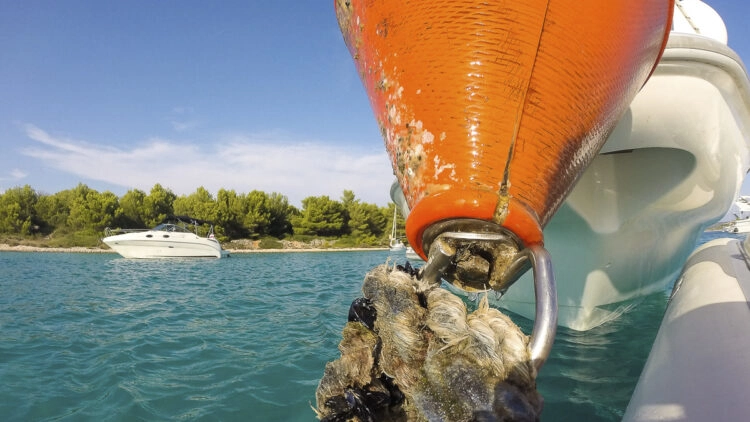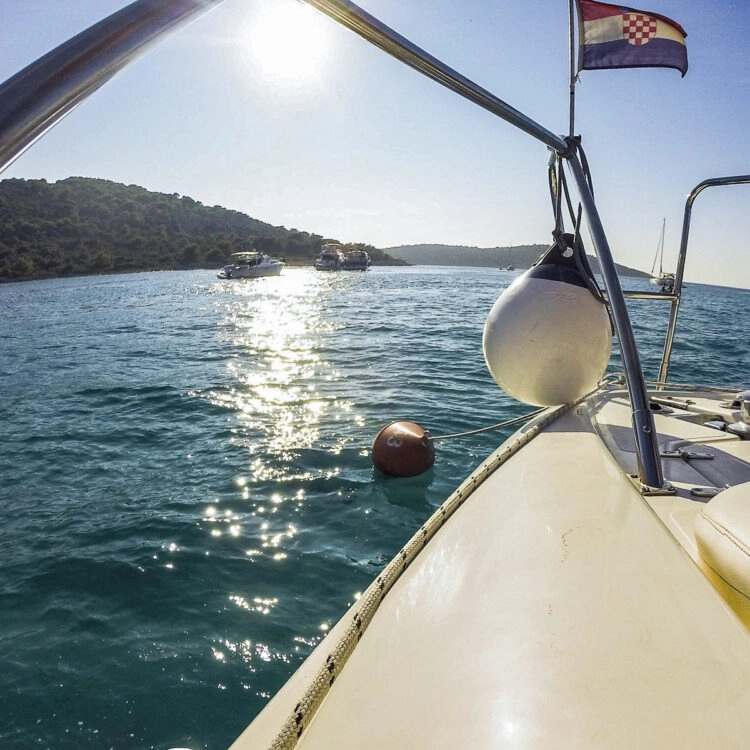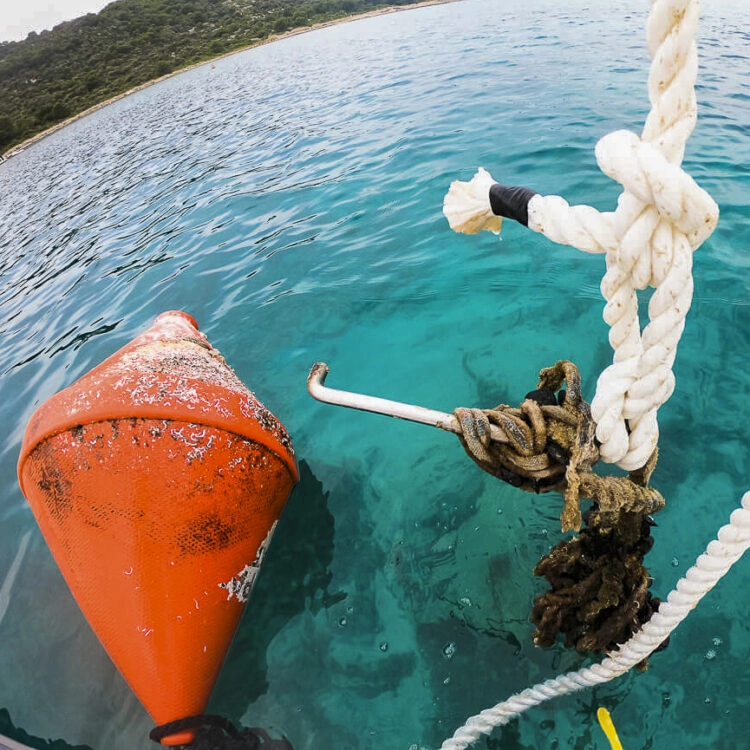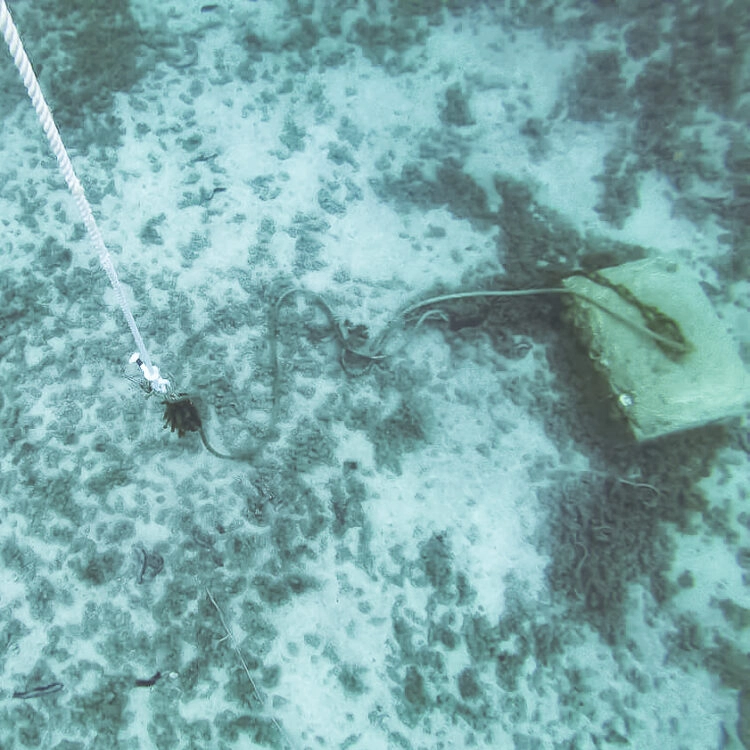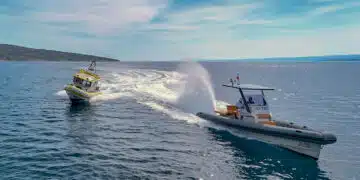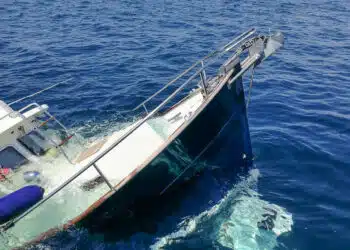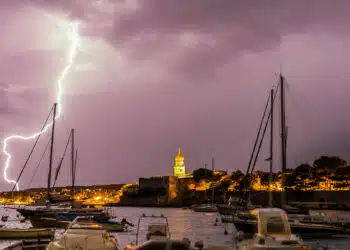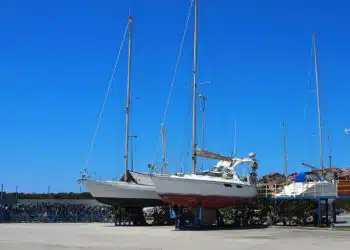No one knows their exact number. But roughly estimated there are well over 120 buoy fields for yachts in Croatia. This number does not include the vast number of restaurant buoys and small camping buoys for trailer boats. How you can tell how safe a buoy is and why misjudgments lead to accidents, explains the following article..
“Going to the buoy is always safer than anchoring.”
This widespread opinion you often hear. But how is it really with it?
The fact is: A well-maintained buoy field is safe. But in the relevant cruise guides can be found again and again references to unsafe, because poorly maintained buoy fields – the “black sheep” among buoy fields are thus known for years. SeaHelp founder Wolfgang Dauser estimates that 15% of all buoy fields for yachts have maintenance deficiencies.
SeaHelp’s tasks also include salvage operations. salvage means rescuing vessels that are unable to reach safety under their own power. “About 80% of these salvage operations are caused because buoys or anchors do not hold”, Wolfgang Dauser summarizes his experience at SeaHelp. “And of these, 70% are caused by trailer boats, the other 30% by larger yachts. Most of them suffer groundings, which are caused at the berth – that is, buoy field or anchor ground – and not in motion.”
The most common causes are torn lines to yachts that go on drift along with the buoy in a strong wind because the buoy weight on the bottom or the buoy harness can not withstand the wind pressure.
And how is it now really about the above assessment?
Wolfgang Dauser’s assessment: “If you anchor correctly, anchoring is safer for me than the buoy. Unless you dive down to the concrete block and pull up an additional mooring line through the eye.”A procedure that you should use especially in strong wind or storm situations.
“That one looks good, doesn’t it? I’ll hang onto it!”
How can you tell a buoy with maintenance defects? Often, just a visual inspection is enough.
Criterion 1: Especially the buoys within larger ports, such as Umag or Novigrad, are maintained by the local port authority, that is, a nautical authority. Trustworthy buoys such as these are labeled with tonnage information on the holding power in tons, as well as current prices – a first indication of care of an operator in the management of the buoy field.
Criterion 2: Buoys without shells are new. Older buoys should be free of proliferating mussel growth on the underside. Coarse mussel growth indicates that they did not come out of the water over the winter – other than required – and probably the mooring was not checked by divers in spring. Wolfgang Dauser: “If the float is not maintained at the top, it looks just as unkempt at the bottom of the mooring. If mooring lines are covered with mussels, that is a sign to be careful. Also, buoys that hang their heads and bob at an angle should be treated with the same suspicion as those that hang low in the water. Their float may be damaged or the downward tension to the mooring may be too great.”
Criterion 3: If you are in doubt about whether a buoy will hold, it never hurts to look the buoy operator deeply in the eye during checkout and ask him guilelesslyabout the holding power and the last maintenance. Two questions that aim at concrete data and information. If the answer is vague and unsatisfactory, or if there is a shrug of the shoulders, you should remain suspicious.
Criterion 4: After mooring, it is good to grab snorkel and diving goggles and briefly take the buoy under water in sight. Does the line lead straight up from the concrete block? Or is the concrete block upside down with the eyelet and line attachment buried underneath it, causing the line to rub against the bottom edge of the concrete block when pulled?
“Going to the buoy is easy. You can’t do much wrong.”
Many skippers occupy the line to the buoy on their forecastle incorrectly, is Wolfgang Dauser observation: “Running the line in a V-shape from the starboard cleat through the eye of the buoy, then occupying it on the port cleat, is dangerous. It can lead to chafing of the line. The eye is often rough like a rubbing iron that can saw at chafing mooring lines for hours. Especially in strong winds through the night, the line may give up. Correct mooring always means mooring the beginning and end of the line on one cleat. I can then also choose whether I want wind or sun on port or starboard.”
As for attaching the line to the buoy, be sure to follow the description printed on most buoys. If there is a line leader on the buoy, you should use this line leader if it and the buoy look pristine.
More and more in use in Croatia are buoys that, in addition to the usual line leader, also have a pilot line to a mooring, which should be attached to the stern as a shore mooring. Or buoy fields according to the English system, in which for a ship one buoy is ready at the bow and one at the stern. As unusual as these special forms may be the first time: you should always follow the instructions on the buoy.
“At the buoy, I always know what I’m paying for.”
Even at port offices, the prices printed on the buoy often differ from those actually charged, and both in turn differ from what is ultimately written on the receipt. Often there are “surcharges” compared to the indicated prices. Often the buoy operator stubbornly refuses to issue a receipt. For the skipper this is unacceptable. If a receipt cannot be presented during official inspections of vessels, fines of several 100 kuna can be imposed.
“At the buoy, there is no way I can collide with another vessel. Or run aground.”
One often encounters unusually narrow buoys, an indication that ships hanging from them went on drift during the season in the storm, together with the buoy, and that the concrete weight on the bottom was not sufficient for the size of the ship.
Wolfgang Dauser: “Especially campsites often offer cheap buoys as an additional service for trailer boaters. Above all with these smaller buoy berths the basic weights are also times any concreted sunshade stands. If a summer thunderstorm passes over the buoy field of a camping site and it knocks 30 boats ashore, we are often busy for days to pull the boats from the shore back into the water. Even for light trailer boats, the buoy anchorages are often inadequate.”
How must a base weight be sized?
“As a rule, the mass of a concrete block is half a cubic meter, which corresponds to 1.2 to 1.3 tons of weight”, knows Wolfgang Dauser. “You can’t move a concrete block like that. If it sits in the mud, the vacuum holds it in place and nothing can get it out. Such dimensioned concrete blocks hold in doubt more than the harness, which is there on it.”
So if you like to sleep quietly, you should avoid buoys that are too close together. Especially nocturnal calm can be deceptive – and schwojende yachts collide.
“Buoy operators? They earn a golden nose from their buoys. And for that, they often don’t even take the trash.”
Contrary to what you might think, running a buoy field is not very lucrative and is usually done as a sideline – “the typical extra income of a Croatian family”, says Wolfgang Dauser.
A buoy brings in revenue on about 100 days a year. If you calculate the usual average price of 20kn per meter, a buoy generates about 3,000 euros a year. First of all, 25% Croatian value added tax must be deducted from this. Then the costs for the state concession of about 0,50 Euro per square meter for the water surface; with 1.500 – 2.000 square meters thus up to 1.000, – €. To this must be added the cost of new purchase of a safe buoy including harness and anchoring of about 1.000 – 1.500€ – makes on 5 years of use 300-400 Euro per buoy per year. From the remaining 1.050,- € 2-3 % concession on turnover, the annual buoy maintenance, divers, a motor boat including fuel as well as the seasonal buoy personnel must be paid.
It is little wonder that buoy operators cannot also take out expensive liability insurance to cover damage to yachts caused by the buoy, given the narrow net income. A nuisance for every skipper, but in case of damage therefore not the buoy operator is liable, but every skipper himself.
The removal of the garbage is a service that many buoy operators offer free of charge. If his boat is full in the evening with the garbage bags, he must already consider whether he can afford it on 100 days to make two or even three times daily free garbage disposal journeys.
No miracle therefore that Wolfgang Dauser comes to the conclusion: “After our economic yardsticks a buoy field counts itself only rarely. But these are our standards. And an excuse for negligence in the maintenance of a buoy field is not at all.”
Tip from the SeaHelp editors:
In our SeaHelp app you can also find anchor bays on the “info map”, as well as many drone photos, drone videos and 360 degree images, so you can already look at many bays in advance and plan your trip perfectly.
Download SeaHelp app:


